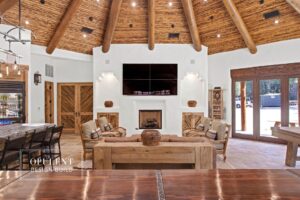Designing a new home is one of the most exciting projects a person can take on. From the floor plan to the finishes, every detail reflects your lifestyle and priorities. Yet one essential aspect is often overlooked during the planning phase—home security.
Building security into the design from day one not only makes your home safer but also saves money and effort compared to retrofitting systems later. Whether you’re working with an architect or designing your own plans, incorporating security features early ensures that protection blends seamlessly with beauty.
Why Home Security Design Matters
When security is an afterthought, you’re limited by what the finished structure allows—where you can place cameras, how you route wiring, and which entry points you can reinforce.
A security-minded design, on the other hand, integrates safety without sacrificing style. Lighting, landscaping, window placement, and even the type of door hardware all play roles in keeping your home safe. Smart planning can make security nearly invisible while remaining highly effective.
When it comes time to select a home security provider, take the time to research and compare home security company reviews. Reading verified customer experiences can reveal how reliable each company’s monitoring service, equipment quality, and customer support truly are. Look for consistency in reviews—positive feedback about quick response times and easy-to-use apps often indicates a dependable provider. On the other hand, repeated complaints about false alarms or poor technical support are red flags. Choosing a highly rated home security company not only improves protection but also ensures long-term satisfaction and confidence in your investment.
Step 1: Start With a Secure Site Plan
Before a foundation is poured, think about site visibility and access.
- Natural Surveillance: Position your home to maximize visibility of driveways, entryways, and outdoor spaces from key interior rooms.
- Fencing and Boundaries: A clearly defined perimeter deters casual trespassers. Choose fencing that complements your design while discouraging easy climbing.
- Entry Points: Limit the number of accessible entrances and ensure they’re well-lit. If possible, create a single, visible main approach to the home.
These early choices can drastically reduce vulnerabilities before construction even begins.
Step 2: Use Architecture to Enhance Security
Architectural layout plays a direct role in crime prevention. Consider:
- Strategic Window Placement: Avoid placing large ground-level windows behind tall shrubs or fences that obscure visibility.
- Limited Hidden Areas: Eliminate blind spots where someone could hide—especially near garages, patios, or basement windows.
- Solid Entry Design: Position doors away from corners or alcoves where visibility is limited. Recessed entries can look elegant but should include lighting or smart video coverage.
Well-planned architecture creates “defensible space”—a design concept that encourages visibility and territorial control.
Step 3: Choose Secure Building Materials
The materials you choose influence both appearance and durability, but they also impact safety.
- Doors: Solid-core or metal doors are much more resistant to forced entry than hollow-core models.
- Windows: Opt for laminated or tempered glass that resists shattering. For added safety, install window locks or smart sensors.
- Garage Access: Treat garage doors as primary entry points. Reinforce with smart openers, sensors, and motion-activated lighting.
Using stronger materials doesn’t compromise design—it enhances longevity and peace of mind.
Step 4: Layer Security Through Lighting and Landscaping
Your outdoor environment can be both welcoming and protective when designed correctly.
- Lighting: Illuminate driveways, walkways, and entrances with motion-activated or dusk-to-dawn fixtures. Layer lighting at multiple heights for both aesthetics and deterrence.
- Landscaping: Trim shrubs near windows and doors to maintain sightlines. Use thorny plants beneath windows for natural defense.
- Smart Integration: Modern lighting systems can integrate with smart security systems, allowing remote control or automatic scheduling.
The right mix of light and landscape discourages intruders while highlighting architectural features.
Step 5: Design for Smart Security System Integration
A dedicated section should focus on the home security system itself—how it ties everything together.
Building with security in mind means leaving space, wiring, and network access for today’s technology and tomorrow’s upgrades.
Key elements to plan for:
- Structured Wiring: Conceal cables and conduits for cameras, sensors, and control panels during construction.
- Central Hub Placement: Allocate a protected space (like a utility closet or office) for your home security hub, Wi-Fi router, and smart home devices.
- Camera Angles and Coverage: Pre-plan camera locations around entrances, driveways, and rear access points. Run power and network lines while walls are open.
- Smart Locks and Sensors: Choose door hardware compatible with your preferred ecosystem—Google Home, Alexa, or Apple HomeKit.
- Alarm and Monitoring Integration: Ensure your builder coordinates with the security company to properly install sensors and connect them to power and Wi-Fi.
This proactive approach prevents visible wires or misplaced devices that can compromise both design and functionality.
Step 6: Consider Lifestyle-Based Security Features
Your home should fit how you live. Tailor security to your routines:
- Families with children may need smart locks or video doorbells that track arrivals.
- Frequent travelers benefit from remote monitoring and smart lighting schedules.
- Homes in rural areas might emphasize perimeter detection, while urban homes may focus on entry and window alarms.
A security system should be personalized, just like your home’s design.
Step 7: Balance Privacy and Visibility
Privacy and security sometimes seem at odds—tall fences or tinted windows can protect from view but also give intruders cover. The goal is balance.
Use architectural screening, landscaping, and lighting to preserve privacy without creating hiding places. Indoors, smart window treatments can automatically adjust to protect your home when you’re away.
Step 8: Future-Proof Your Home’s Security Design
Technology evolves quickly. Choose flexible systems that can grow with your needs.
- Use modular or wireless security components for easy upgrades.
- Install extra conduit for future devices.
- Keep the central control system software-update ready.
- Designate an equipment closet for hidden routers, hubs, and network drives.
A home designed for adaptability will stay secure as technology changes.
Final Thoughts
Building a home with security in mind isn’t about turning your space into a fortress—it’s about integrating protection seamlessly into design. When architecture, materials, lighting, and technology work together, security becomes invisible yet ever-present.
By planning early, collaborating with your architect, and choosing the right security partner, you’ll create a home that’s not only beautiful but also built on peace of mind.






